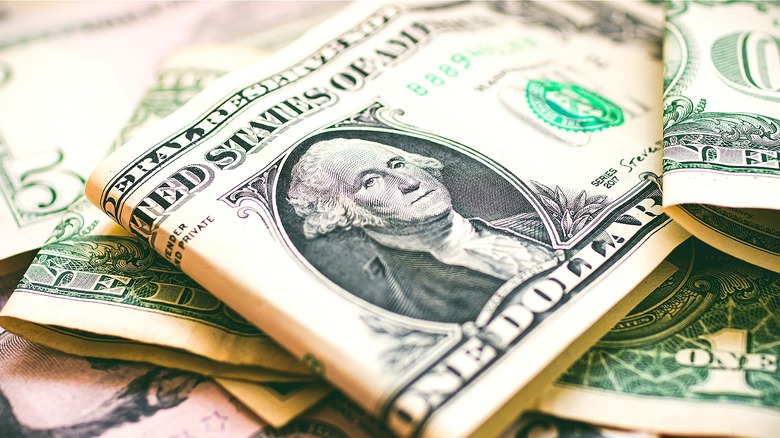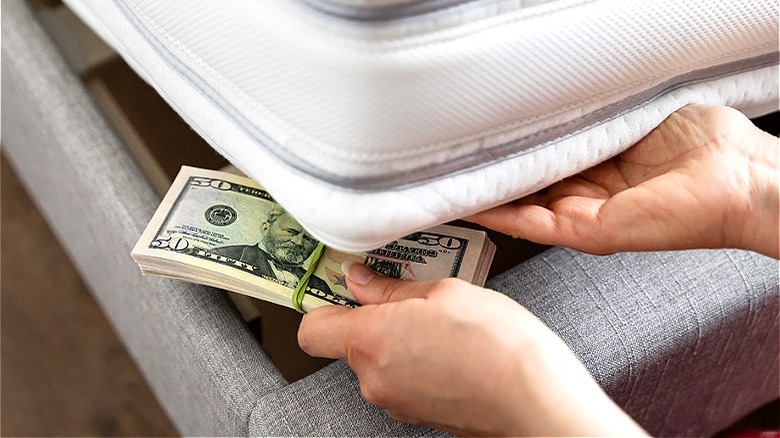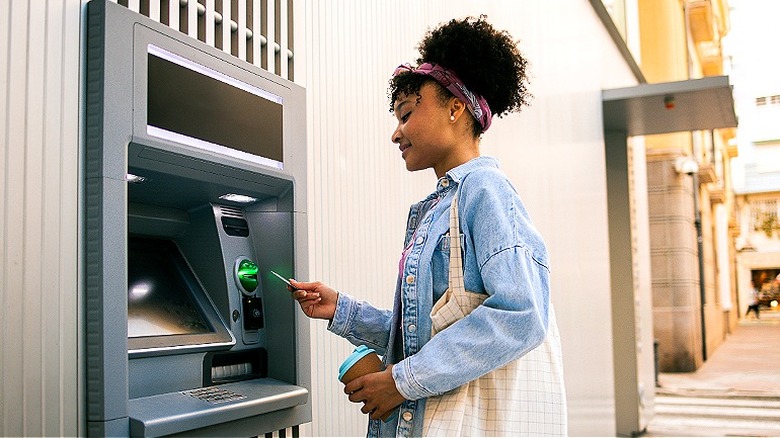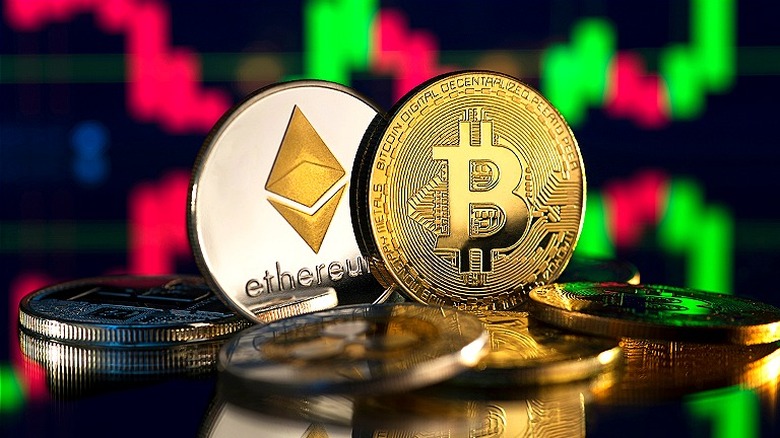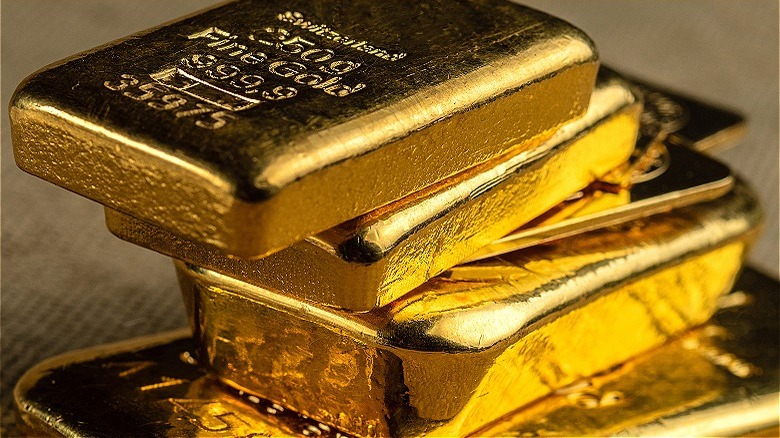The Worst Places To Keep Your Money
Money management has come a long way through the years. While saving up for a rainy day or the future might've been a simple task some decades ago, today, the need to set money aside has become complicated by high inflation rates, wage stagnation, and the accumulation of ever-increasing debt burdens. The economic landscape in America continues to grow and flourish, but the individual wage earner appears poised for battle with an economic complexity that shows no signs of slowing down its menacing transformation.
Putting coins in a jar or stashing a few notes in your sock drawer might have been viable savings strategies many years ago, but they no longer pass muster. Today, socking away a few bills or coins is only really valuable as a financial learning opportunity for children. Instead, ETFs trading on the stock market, retirement savings accounts like Roth IRAs, or other muscular growth opportunities offer themselves up as the best investments for your long-term savings while high-interest savings accounts and strategies like CD laddering have proven valuable for emergency fund resources and other short-term capital set aside. Even with a few good options laid out, it's worth noting the various ways in which people stash funds that should no longer stay on the table. These are the five worst places you can keep your money; vessels that should leave your thinking entirely.
Stored away under a mattress
First and foremost, any cash kept with the intention of utilizing the money as savings is money that loses value year over year. Inflation is a consistent enemy of the consumer, and its effects are seen most prominently in cash holdings. Simply put, your dollar is worth 2% to 3% less every year than the previous year. Practically, what this means is that everything you regularly buy increases in price gradually over time; you may also see this in the form of shrinkflation. During periods of economic stress, inflation might rise higher, leading to rapid price increases that really hit consumers where it hurts. During the pandemic years, for example, inflation in the United States rose to 8.6% in May 2022, the highest since 1981. The result was that every dollar consumers spent was worth nearly 9 cents less than its face value in real spending power.
A checking account and many other buckets that consumers use to hold their money don't tend to provide interest or other valuable returns on the cash. But at least a financial institution offers a layer of protection to your capital. If you keep money under your mattress, in a sock drawer, or anywhere else in cash, it can be lost, damaged, destroyed, or even stolen as a result of forces existing beyond your control. These features make it the absolute worst place to keep your money.
Sitting in a checking account
In the same way that cash savings should be avoided at all costs, cash placed in a checking account doesn't do anything to grow its value. Specifically, savings capital you leave in a checking account is not likely to benefit from interest payments, meaning that it is doing nothing to combat the value pit of inflation. Fortunately, any checking account at a U.S. bank is almost assuredly covered by FDIC deposit insurance. This means that if the bank loses your money or goes out of business, the federal government will make you whole — up to $250,000. This provides an added sense of security over strictly cash savings, but leaving money in a checking account suffers from its unique vulnerability.
A consumer's checking account is designed specifically for routine spending. Whether you funnel most or all of your payments through a rewards credit card or pull out your debit card for everyday purchases, this bank account is likely where you get paid and how you spend your money. Leaving additional cash resources in this account puts them at risk, however, of being spent unintentionally. Pooling your savings and spending money together creates a blurry line between the two, one that can easily vanish. If these funds are part of your emergency cash resource, a hazy divide can leave you in a tricky position in the event the money is needed.
Deposited in a standard savings account
Not only is a checking account one of the worst places to keep your money, but the institution you use for everyday banking shouldn't hold your primary savings account, either. With standard savings off the table as well, it can seem like there's no good place to keep cash resources. But the reality is that big banks across America don't offer interest rates that should excite anyone. As of March 11, 2024, the national average for savings account interest rates stood at 0.57% APY. When weighed against inflation, this value is simply abysmal.
Truly, the only benefit a savings account with your standard bank provides is the potential for fast transfers between accounts in the event you need immediate access. There is an alternative, however. Online-only savings banks and even local credit unions in your area often offer drastically improved interest rates. Internet-based savings banks claim that by doing away with brick-and-mortar locations they can cut costs so dramatically that their rates can sustainably rise to 10 to 12 times the national average. Options include Barclays, SoFi, and Jenius Bank. But it's worth looking into personally to identify the best fit for your individual needs.
Invested in cryptocurrencies
Cryptocurrencies are volatile investment (and quasi-traditional monetary) assets. Value fluctuates wildly, and exchanging crypto assets for fiat currency isn't always a straightforward or even cost- effective process. Crypto really shouldn't ever be relied on solely for their purchasing power. The market is finicky, and value can skyrocket or crater in any given cryptocurrency token without so much as a hint of the transformation. This gives investors two opposing reasons to worry. Not only might your saved capital disappear overnight, if you do use it for spending purposes, but any of the tokens exchanged for goods might end up worth exponentially more, leading to a sort of financial FOMO, or fear of missing out.
Many investors have brought crypto assets into their portfolios as a risk-infused opportunity for potential growth. But cryptocurrency should only make up a small portion of your invested capital, and it should never be an arena that you use to park savings or any other cash you may need in the short term. Moreover, withdrawal rules and regulations, as well as shifting tax implications, make cryptocurrencies a difficult commodity to fully understand and utilize at any given point in time. While the cryptocurrency marketplace is a volatile, and often exciting, space for traders, when it comes to your savings, it acts as a shark-infested backwater with little regulation and plenty of opportunity for severe loss.
Exchanged for precious metals
Lastly, savers looking to lock in great value appreciation might consider investing their money in long-term CDs or even buying into gold or other precious metal coins or bullion. Exchanging your liquid savings capital for one of these highly illiquid asset types might offer better returns, but these kinds of savings tools are difficult if not impossible to liquidate on your own terms, and in the case of physical gold or other precious metals, you'll need to find a secure place to store the assets, too. Therefore, such assets should be considered investment tools rather than savings opportunities.
An alternative that'll still bring you into contact with these kinds of assets can be found, however. Stock market ETFs that track gold and other commodity prices can help you invest in the precious metal space without having to commit capital to a physical asset that's hard to resell with any kind of haste. As well, CD investors have opted for a strategy called laddering that breaks up the total sum of invested money into multiple CD accounts that mature at staggered intervals. This is something many smart savers actually deploy to great effect. Instead of placing all your cash in one CD, purchasing multiple certificates of deposit allows you to withdraw a portion of savings at regularly scheduled points in time, if needed. Alternatively, these funds can also be reinvested (often with automatic permissions available) for continued high-interest returns.
